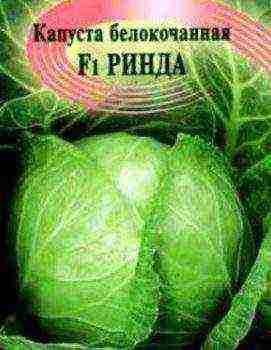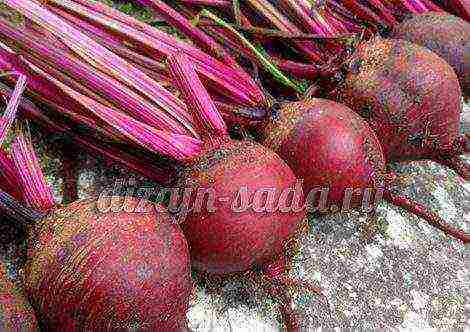Content
It is difficult to imagine a home garden without fruit trees and shrubs, so even the laziest and busiest owners of backyard plots cannot refuse apple trees, currants, and raspberries. More sophisticated gardeners indulge themselves with curiosities, trying in every possible way to create conditions suitable for them. And we suggest adding to your garden such a not yet widespread, but unpretentious fruit plant, like barberry. This shrub has not only decorative, but also high taste and medicinal properties.
It belongs to the huge family of barberry, which includes more than 170 species, but fruit species and varieties are represented in it by only a small group. In the Soviet Union, Tajikistan was the main producer and supplier of this tasty and healthy berry: favorite candy "Barberry", lemonade, syrups, medicines - everything was made from berries grown in the hot Asian climate. But there are certain varieties and types of fruit barberries that feel great in our Ukrainian gardens. But before moving on to the varieties, some general information.
Barberry (lat. Bérberis) is a valuable fruit shrub. In places of natural growth - in the Caucasus, Southern and Eastern Europe, Asia - he prefers to settle in dry and light areas near forests, on mountain slopes, and marginal soils. Its rhizomes are creeping, lignified. The shoots are high, 2-3 m, erect, depending on the species, as well as the season, have a purple, yellow, gray-white color. Leaves are elliptical, 4 cm long and 2 cm wide, located on shortened shoots. Spines up to 2 cm in size develop on long shoots. Fruit clusters consist of 15–25 yellow or bright orange flowers, which after long flowering (from April to May) turn into scarlet or purple sour fruits. The ripening period of berries depends on the type of fruit barberry - from September to early November.
The ripening period of berries depends on the type of fruit barberry - from September to early November.
The fruits contain a large amount of vitamins C, E, organic acids, as well as berberine, a natural alkaloid widely used in traditional and folk medicine. Also, barberry is a good honey plant - honey acquires a bright golden yellow color and a delicate pleasant aroma.
Types of edible barberry
Common barberry (Latin Bérberis vulgáris) is a tree-like shrub with a spreading crown. The distribution area is the Caucasus, Southern Europe, but it easily takes root even in Siberia. It is undemanding to soils, at home it can be found even in the most unsuitable areas for cultivation, such as river pebbles, chalk deposits. The main advantage over other fruit barberries is its high winter hardiness, it is able to withstand frosts down to -35 ° С.Prefers dry and sunny areas of the garden. Shading negatively affects the yield and taste of the fruit. The close occurrence of groundwater and abundant watering can lead to decay of rhizomes.
Common barberry is perhaps the only species among edible counterparts that has the greatest varietal diversity:
● Lutea - bush up to 2 m high with yellow shoots and light green foliage. The fruits are golden yellow, sour. Planted only in open, sunny areas of the garden.
● Aureo-marginata - the bush can reach a height of 3 m, has very beautiful leaves, bordered by a silvery stripe. Very effective in hedges. The fruits are scarlet, tasty, sweet and sour, ripen in October.
● Atropurpurea - the height of the bush does not exceed 2 m, purple shoots with dark red leaves and fruits. A very spectacular bush. Berries are picked in late September - early October.
● Alba-variegata - the bush is valued for its high decorative effect. The foliage is "painted" with white stains, the color of the fruit is creamy white.
● Dulcis - the variety contains all the species characteristics of the common barberry, but is distinguished by the high palatability of the fruit: the berries are very sweet, ripen by mid-October.
● Asperma - a tall bush bears fruit with red seedless berries.
In our gardens, another type of this plant has proven itself well - Amur barberry... Growing area - the Far East, Korea, China. It was first met by botanists on the banks of the Amur, for which it got its name.
Amur barberry (Berberis amurensis) - low-branched thorny shrub with a spreading crown up to 3.5 m high. Shoots are painted in a yellowish tint, by autumn they become gray-yellow. The color of the leaves also changes with the seasons: in summer they are bright green, and in autumn they are red or golden-red. The flowers are light yellow, very fragrant, spines up to 2 cm. Fruits are red, shiny, edible. Harvesting is carried out in late autumn - in November.
The species is presented in two varieties:
● Japonica - differs in more rounded leaves and a small number of flowers on the racemes.
● Orpheus Is a non-flowering variety bred by Russian breeders exclusively for decorative purposes. The height of the bush is 1 m.
It is impossible not to mention several more types of barberries with fruits that have nutritional value. But, alas, these species are not entirely suitable for growing in our climatic zone.
Canadian barberry (Berberis canadensis). The shrub grows in the valleys and along the river banks of North America. It blooms profusely from mid-May to June, unpretentious, easily tolerates drought and winter frosts.
Outwardly, it is not much different from the common barberry. A species unfamiliar to our gardeners is being intensively improved by American and Canadian breeders, who are working towards the decorative effect of the bush. But sometimes the taste of the berries is lost.
Ball-bearing barberry (Verberis sphaerocarpa). It is multi-legged - a spectacular bush up to 2 m high, smelling strongly during flowering. The place of distribution is the mountain slopes of Central Asia, Mongolia, and the western provinces of China. It is its fragrant blue-gray fruits that are used to prepare traditional Asian dishes - shurpa, pilaf, lagman.
Note for the most daring gardeners, collectors and experimenters: in the conditions of our winter, the culture can completely die - in order to preserve the species and get the harvest, you should take care of the greenhouse shelter of the bush.
Agrotechnics
Barberry has a high adaptability to any soils and conditions. The main thing is to take into account several immutable rules.
1. On soils with high acidity, plant development is inhibited. The solution to the issue is to add slaked lime to the planting pit at the rate of 500 g per 1 m2 for very acidic soil or 200-500 g of wood ash.
... Barberry is a cross-pollinated plant, so at least 2 fruit bushes should be planted in the garden. Fruiting begins from the 4th year of planting.
... For high and stable yields, barberry should be planted in open, sunny areas.
... A compacted planting can reduce the yield of bushes, so the distance between fruit plants should be at least 1 m.In the case of the formation of a hedge from edible barberry, 2 bushes can be planted per 1 running meter.
For high and stable yields, barberry should be planted in open, sunny areas.
Landing. A planting hole for single bushes is dug 40 × 40 cm in size, for a hedge - a trench of the same depth and required length is prepared. If the soil does not require additional preparation or deoxidation, sand is poured onto the bottom of the hole, thereby facilitating aeration of the rhizome. Saplings are placed, lightly sprinkled with earth and watered well. After the water is absorbed into the soil, the pits are completely covered and lightly tamped. Mulching the root zone will create favorable conditions for the rooting of the plant and free the gardener from the necessary frequent loosening of the soil.
Watering. An excess of moisture is detrimental to barberry, so newly planted bushes are watered once a week, and adult plants - as needed, 1-2 times a month.
Care. Barberry can be safely called a shrub that does not require much care - it all comes down to dosed feeding, pruning and taking preventive or therapeutic measures. Nitrogen-containing fertilizers are applied only the next year after planting and subsequently no more than 1 time in 3 years. The introduction of complex fertilizers containing trace elements has a beneficial effect on the yield.
Pruning. Sanitary pruning is carried out in the spring, before the start of sap flow - dried, damaged shoots and excess growth are removed.
Rejuvenating pruning is also done in early spring. Completely remove old branches by cutting them onto a stump near the ground. Of the young shoots, the healthiest ones are left, forming a new bush.
Shaping haircut allows you to give the plant a neat look. Barberries are trimmed twice a season - in spring after flowering and at the end of summer, in August.
Reproduction. The breeding process is simple and traditional - sowing seeds, cuttings, layering and dividing the bush.
● Sowing seeds is best done in the fall - for this, seeds are removed from ripe fruits and sown immediately in a prepared bed.
● Cuttings are carried out in July with young semi-lignified shoots in summer greenhouses.
● For reproduction by layering in the spring, strong annual shoots are chosen, bend them into the prepared grooves, fix and cover them with earth, leaving only the top of the shoot on the surface. Throughout the season, the cuttings are regularly watered, and in the fall, young seedlings are moved to containers or a separate bed for growing.
● Dividing the bush is the most painful way for barberry; it is carried out in the spring, carefully cutting the rhizomes of the mother bush with pruning shears. The newly formed divisions should be provided with maximum care: shading, watering with root-stimulating preparations, foliar dressing with Epin, humate.
Diseases and pests. Barberries are not very susceptible to aggressors and viruses, but nevertheless they have weak points: infection with powdery mildew, rust, bacteriosis is possible.
Control measures - standard fungicides and copper-containing preparations.
Dangerous pests include barberry aphids and moths. Aphids spread very quickly, damaging the leaves of young shoots, and the moth larvae destroy the tasty fruits of barberries.
Barberry - a pantry of goodies and goodies
Only well-ripe fruits are eaten, green berries can cause poisoning and painful indigestion. Dried whole or crushed fruits are used as a seasoning for meat dishes, legumes, soups and marinades.Young leaves are used instead of sorrel in salads and green soups.
Those with a sweet tooth appreciated the pleasant berry sourness even in the "Barberry" caramels. Having a sufficient amount of berries, you can prepare a variety of desserts: marshmallow, jelly, jam, marmalade, compotes, syrups, juice.
Barberry jam. Rinse well 1 kg of barberry berries, pour 2 glasses of water and leave for 10 hours. Then pour the water into another saucepan, add 1.2 kg of sugar to it and boil the syrup. Pour in the berries and cook for half an hour. Pour into sterile jars.
Barberry juice
Method number 1. Wash ripe berries, pour into a colander in small portions and blanch in boiling water for no more than 3 minutes. Pass the prepared berries through a juicer. Boil the juice intended for storage and pour it into bottles. Use for making mousses, jellies.
Method number 2. Wash ripe berries, drain with water, then press. Pour the resulting juice into an enamel bowl and pasteurize. Pour into jars, cover with lids and sterilize for another 15 minutes, then seal tightly.
Salted barberry. Put the washed and dried brushes with ripe fruits in glass jars, pour in salted spring or cold salted boiled water, close with nylon lids and store in the refrigerator. Add as a condiment or as a stand-alone snack.
The use of barberry berries in cooking is not the only advantage of this plant. Since ancient times, bark, leaves and fruits have been used in folk medicine for the prevention and control of viral infections, diseases of the genitourinary system, liver and stomach. Eating the fruit leads to a decrease in blood pressure, strengthening the immune system. Decoctions and infusions from the leaves are used as a hemostatic and choleretic agent, as well as for the treatment of psoriasis. Berberine, obtained from roots and leaves, is a part of many medicinal preparations in modern medicine.
Eating barberry fruit helps to reduce blood pressure and strengthen the immune system.
For economic purposes, berries are used to dye yarn, fabrics, leather in bright lemon yellow colors. In the old days, shoe nails were made of solid wood, and today they make beautiful souvenir crafts and decorations.
Large, spreading barberry bushes can be successfully used in garden compositions and create reliable, impenetrable thorny hedges.
As you can see, edible barberries on the garden plot are not only a decorative decoration of the garden and reliable protection from uninvited guests, but also a whole storehouse of vitamins, spices and medicines. Try it!
Barberry is the main representative of the family of the same name. It is a spectacular shrub with beautiful leaves and thorny shoots. It is very difficult not to notice the barberry during the flowering and fruiting period, since at this time it is especially beautiful. In nature, there are about one hundred and seventy species of this plant, each of them has its own characteristics and distinctive features.
Species diversity of barberries
Many of us remember the very Barberry sweets, syrups and lemonades that were so popular during the Soviet era. All these products were made from the berries of edible barberry species. Now many gardeners grow this unpretentious plant on their site. However, not all species take root in our latitudes, but only those that have managed to adapt to the temperate climate.
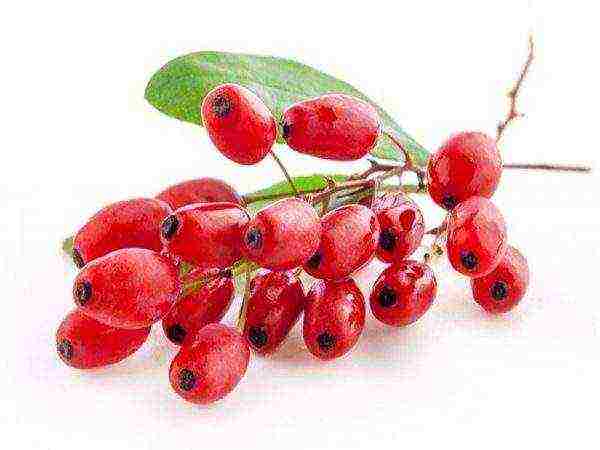
Bright berries of barberry are hard to miss among the garden greenery
The genus of barberry includes many species, among which there are both evergreen and deciduous plants. A common feature of these shrubs is the presence of thorns - single, double, triple, and sometimes even five together. They are located at the base of the kidneys, they can be very hard or soft, almost invisible.
Barberry bushes bloom from late May to early July. Flowers are yellow, small.The berries are light or dark red, sometimes black, with a pronounced sour taste, but quite edible.
Barberry plantations look very decorative throughout the season. Deciduous species are a real gem of the autumn garden thanks to the vibrant color of the leaves and berries.
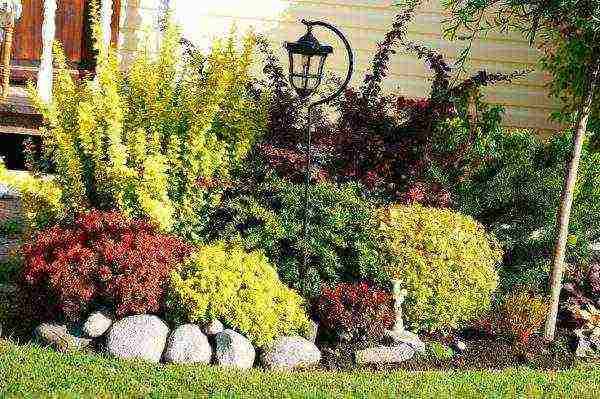
Barberry bushes adorn the garden throughout the season
Next, we will take a closer look at the most popular varieties of barberry.
Edible species
No home garden is complete without fruit trees. Even the laziest gardeners plant their plots with raspberries, apples, pears, but few people prefer such an unpretentious plant as barberry. In addition to nutritional value, it is also worth noting its healing and decorative properties.
Common barberry
The common barberry is most widespread in the Caucasus and southern Europe, but it can also grow in Siberia. Shrubs of this type are resistant to frost, can withstand temperatures up to -35 degrees. The main condition for growing is placing plants in sunny and dry areas. Planting in the shade will negatively affect the taste and quantity of the fruit.
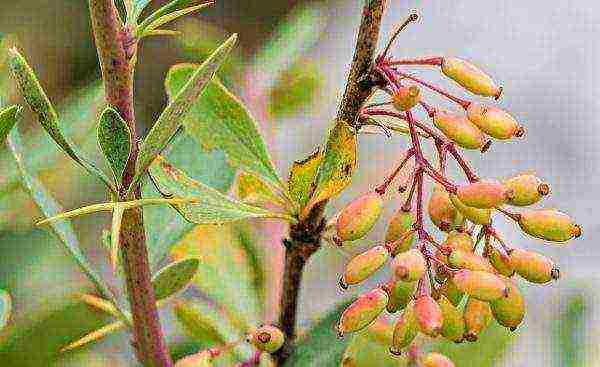
Common barberry is one of the most common representatives of the family, which is distinguished by its unpretentiousness and high frost resistance
The common barberry has quite a few varieties, namely:
- Lutea is a bush up to 2 m high with yellow shoots and light green foliage. The fruits are golden yellow, sour. Planted only in open, sunny areas of the garden.
- Aureomarginata - can reach a height of 3 m, has very beautiful leaves, bordered by a golden strip. Very effective in hedges. The fruits are scarlet, tasty, sweet and sour, ripen in October.
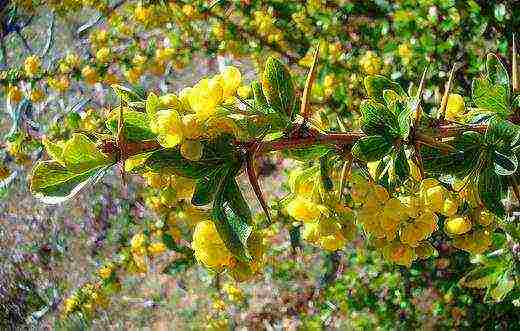
For a decorative hedge, the barberry Aureomarginata is perfect, the leaves of which are bordered with a thin golden strip.
- Atropurpurea - the height of the bush does not exceed 2 m, purple shoots with dark red leaves and fruits. A very showy plant. Berries are picked in late September - early October.
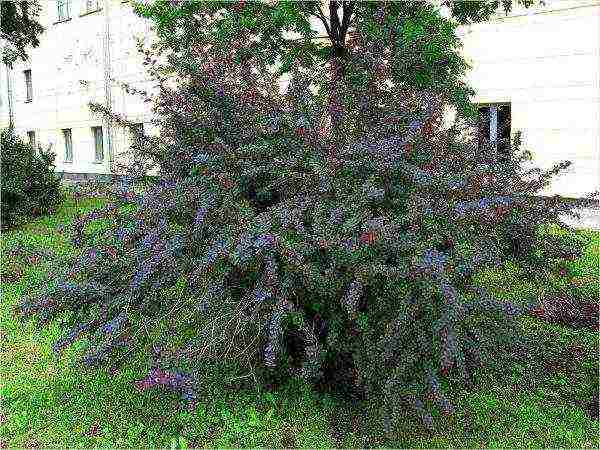
Barberry Atropurpurea with a reddish tint of leaves is often used in landscaping urban recreation areas
- Alba variegata - this variety is valued for its high decorative effect. Its foliage is "painted" with white stains, the color of the fruit is creamy white.
- Dulchiz - has all the specific characteristics of the common barberry, is distinguished by the high palatability of the fruit. The berries are sweet, fully ripe by mid-October.
- Asperm is a tall shrub with red seedless berries.
Barberry syrup recipe. For cooking, you need to mash the berries with the addition of water, then squeeze out the juice. After that, the liquid must be brought to a boil, passed through a filter and granulated sugar added.
Video: characteristics and useful properties of barberry
Amur barberry
Plants of this species are shrubs up to 3.5 m in height. The shoots have spines up to 2 cm long. Depending on the season, the color of the leaves can change, acquiring a reddish tint in autumn. In spring, small yellow flowers with a pleasant aroma appear on the bushes. In November, flowers are replaced by bright red fruits.
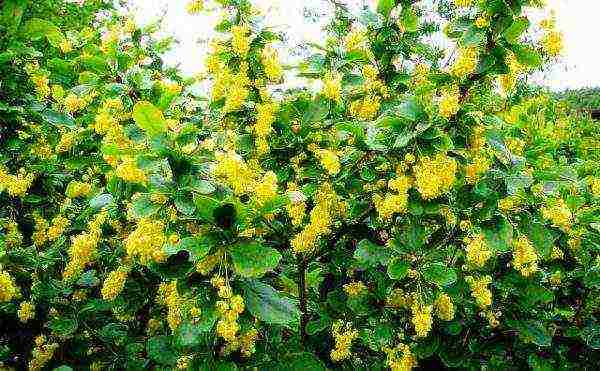
Amur barberry is distinguished by abundant flowering and fruiting
In this species, two varieties are best known:
- Japonica - differs in more rounded leaves and a small number of flowers on the racemes.
- Orpheus is a non-flowering variety bred by Russian breeders exclusively for decorative purposes. The height of the bush is 1 m.
Ball-bearing barberry
This type of barberry grows in Central Asia, Mongolia and China. It is its fruits that are part of traditional Asian dishes such as lagman, shurpa and pilaf. The shrub can grow up to two meters in height. Shiny reddish shoots in spring are covered with spectacular dark green leaves. The yellow-orange inflorescences blooming in early June have a pronounced aroma.The fruits are black, covered with a bluish bloom on top.
The ball-bearing barberry is not very adapted to the climatic conditions of Russia. If you decide to plant this shrub in your garden, make sure you have a good hiding place.
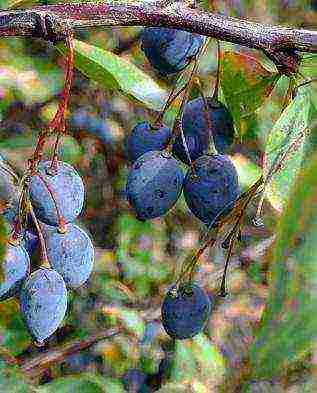
The fruits of the ball-bearing barberry have excellent taste.
The ripening time of barberry fruits depends on its type. Usually the crop is harvested from September to early November.
Evergreen species of barberry
Evergreen barberries include shrubs of different types that differ from each other:
- bush shape;
- frost resistance;
- cultivation features;
- resistance to the conditions of the urban environment.

A living fence made of evergreen barberry is replete with thorns, but at the same time it is incredibly beautiful
Barberry Darwin
This species grows rather slowly, the maximum height of an adult bush reaches 2 m. Most often it is grown for decorative purposes. Darwin's barberry has bright orange-yellow flowers, in place of which black fruits with a bluish tinge appear in the fall. The leaves of the shrub are quite elegant, shiny, with small spines at the ends.
Darwin's barberry has an average winter hardiness, can withstand temperatures up to minus fifteen degrees. The shrub is recommended for cultivation in the southern regions of our country.
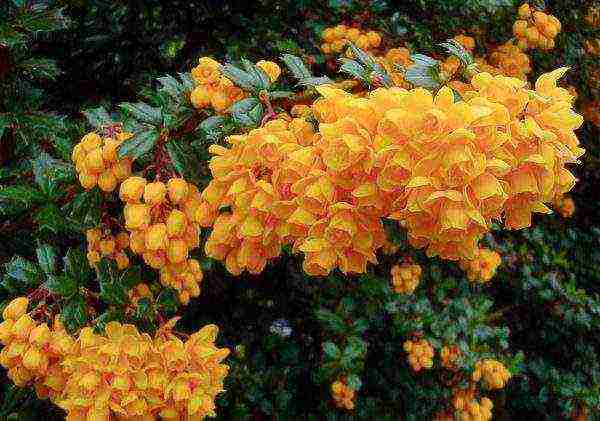
Bright orange-yellow flowers of Darwin's barberry delight the eye in any weather
You can trim the barberry shoots a little after flowering. This will give the bushes a neater and more beautiful appearance.
Barberry Freakarta
This garden hybrid is derived from the warty barberry. The flowering period of this shrub is in May. Its flowers are pale yellow, the leaves are light green, shiny. The berries are inedible, blue-black in color.
The species is quite resistant to low temperatures (up to -23 degrees), but it is recommended for growing in warm climates. Prefers sunny or partial shade places.
Barberry Frikarta is presented in two decorative varieties:
- Amstelveen - grows up to one meter in height and up to two meters in width. Shoots are prickly, arched in shape.
- Telstar is a slow-growing shrub, reaching 90 cm in circumference. The crown is dense, the leaves have a silvery underside.

Amstelveen barberry has a very compact shape
Barberry Ganepena
Barberry Ganepena grows slowly, at the age of 10 it can reach up to two meters in height and in diameter. The plant forms elongated shoots with thorns, which are about two centimeters long. In May, yellow flowers bloom on the branches, which can be either single or collected in inflorescences. At the beginning of autumn, they are replaced by blue-black berries, covered with a white bloom. The fruits are not good for food.
The most popular variety of this species is Klugovski. It was bred in 1960 by Alfons Klugovski in the Flein kennel (Germany). The variety is unpretentious, resistant to both high and low temperatures, as well as to the conditions of the urban environment. Doesn't like excessive moisture.
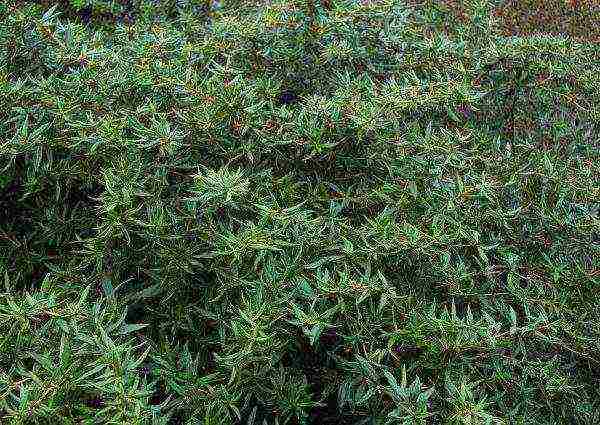
The dark green leaves of the Klugovski variety have jagged edges.
Juliana's barberry
A slow-growing shrub that at the age of 10 is capable of reaching up to two meters in length and up to four in width. The leaves of Juliana's barberry reach 10 centimeters, have needles at the ends. The color of the leaves is dark green, at a young age - with a bronze tint. Flowering occurs in mid-May or early June. Flowers are collected in clusters of 8-15 pieces, painted yellow with a red frame. At the end of September, black-blue fruits ripen on the bushes.
Juliana's barberry is resistant to temperature extremes, as well as to urban conditions. Prefers sunny location. Shrubs of this type are highly decorative, they are often used for landscaping areas.
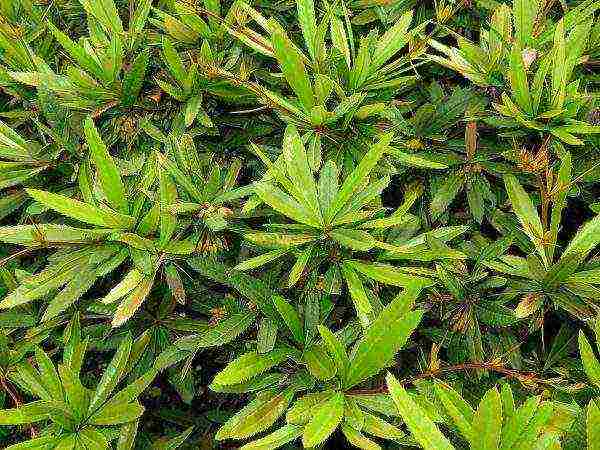
The edges of the leaves of Juliana's barberry are protected by small but very prickly needles.
Dwarf barberries
The dwarf varieties of the Thunberg barberry are of the greatest value for landscaping. They are great for curbs and low hedges. Usually barberry is combined with conifers, however, alone, the bushes look amazing.
Decorative deciduous varieties
Low-growing Thunberg barberries can have a different color of leaves - from pale yellow to burgundy. The most popular varieties are:
- Bagatelle. A beautiful dwarf shrub that does not exceed 40 cm both in height and in diameter. The small leaves, painted with a bright purple color, reach a length of 1 cm. The flowers have a delicate yellow color and grow in bunches. At the end of September, edible red oblong berries ripen on the bushes. Bagatelle is susceptible to freezing in winter, but it is quite heat resistant. The plant is unpretentious, but it needs good lighting.
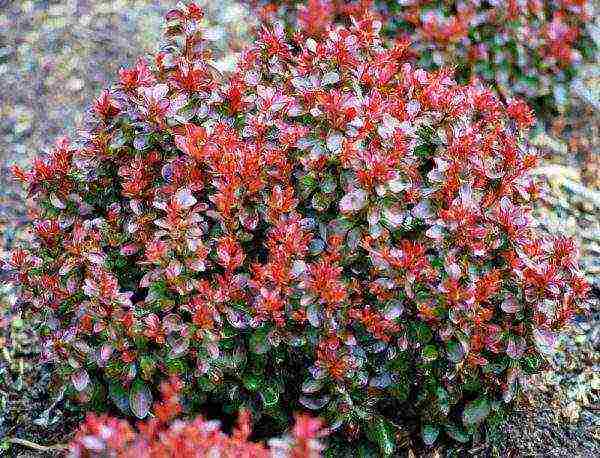
Barberry Thunberg Bagatelle stands out brightly against the general background due to the crimson color of the leaves
- Kobold. The size of an adult bush does not exceed 50 cm. Small emerald leaves (no more than 1.5 cm long) turn bright yellow in autumn. Kobold bloom begins in May. Yellow flowers with a red rim do not exceed 1 cm in length. They are replaced in September by pink or red fruits that can be eaten. The shrub is not at all picky about habitat conditions. Resistant to heat, frost-resistant, tolerates urban conditions. Likes to sit in the sun, but also perfectly tolerates shade and partial shade.
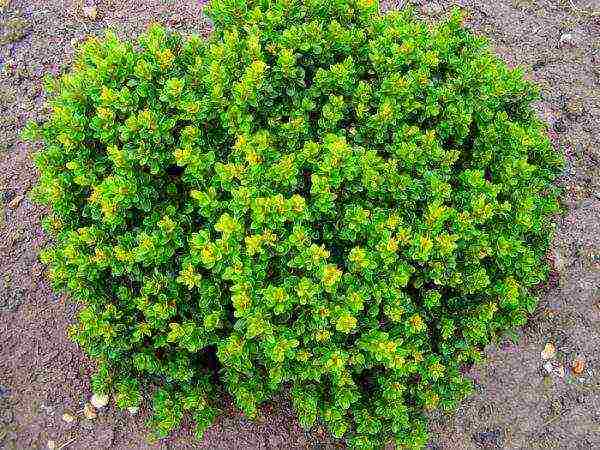
Small exquisite bushes of Kobold barberry are often used for landscaping city parks
- Bonanza Gold. An incredibly beautiful plant with a very dense pillow-like crown. This small but exquisite bush reaches a height of 50 cm and a width of no more than 70. The leaves of the bush are very small, have a bright lemon shade. Flowers, like leaves, are yellow. In September, edible red fruits appear in place of the bright flowers. Barberry Bonanza Gold is drought and heat resistant, but in winter it can be prone to freezing, which is why it loses part of the crown. The shrub of this variety recovers very quickly and by the beginning of June it acquires its former appearance.
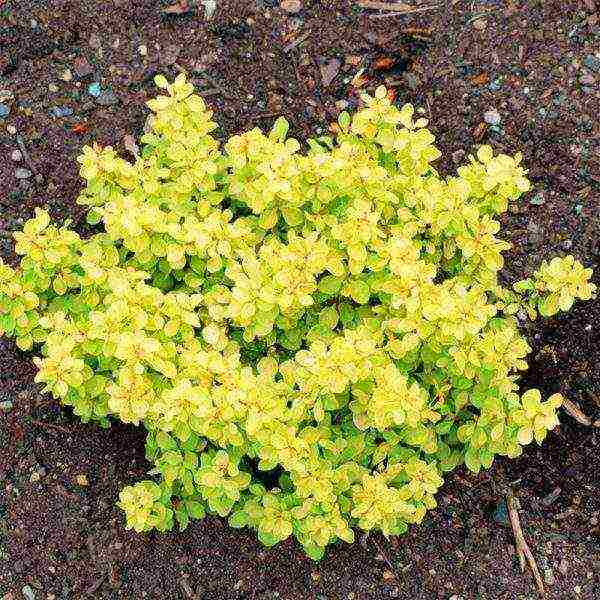
Even in bad weather, the Bonanza Gold barberry looks like it is illuminated by the sun.
- Atropurpurea Nana. It is a low-growing bush with a wide-round crown. The leaves are purple in color, which changes to fiery red in the fall. This variety of barberry blooms from May to June. The flowers are small, light yellow. Closer to September, bright red oblong berries appear on the bushes. Atropurpurea Nana prefers well-lit areas, however, there are no problems with growth in shady areas. The variety is quite resistant to heat and cold, does not like stagnant moisture in the soil.
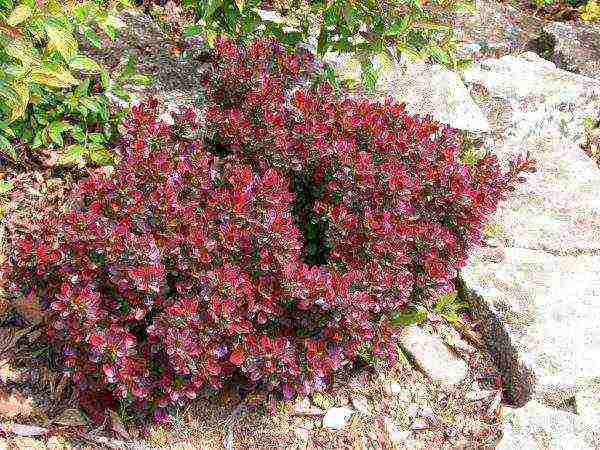
The purple color of the leaves of the barberry Atropurpurea Nana turns into fiery red with the arrival of autumn
Video: popular varieties of barberry
The best variegated varieties
Over the past decades, breeders have bred decorative varieties of Thunberg barberry with brightly colored foliage of several colors: lemon, purple, red. Such shrubs can be a real decoration for any garden.
Among the variegated varieties of Thunberg barberry, the most decorative are:
- Admiration. The annual growth of this variety does not exceed 3-4 cm. The maximum height of an adult plant is 50 cm. The leaves reach up to three centimeters in length and are colored bright red with a yellow frame. In May, yellow-red inflorescences appear on the bush. During fruiting, the plant produces bright red berries that are not suitable for human consumption. Barberry Administration is resistant to urban conditions. In winter, the rhizomes and stems can freeze over, so it is advisable to cover the shrub.
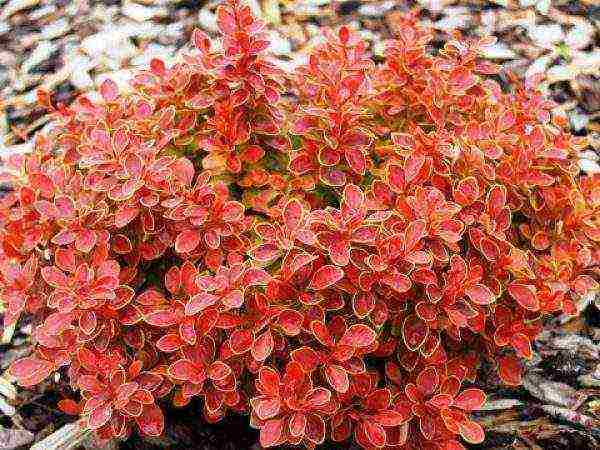
Barberry Administration has brightly colored foliage and is able to decorate any garden
- Special Gold. It is a dwarf shrub that grows very slowly. The maximum height of an adult plant is 20–30 cm.Its leaves are rather small, yellow-green in color. Barberry Special Gold blooms in May with yellow flowers. Resistant to heat, frost and urban conditions, and is also resistant to pests. Prefers sunny location, but can grow in the shade.
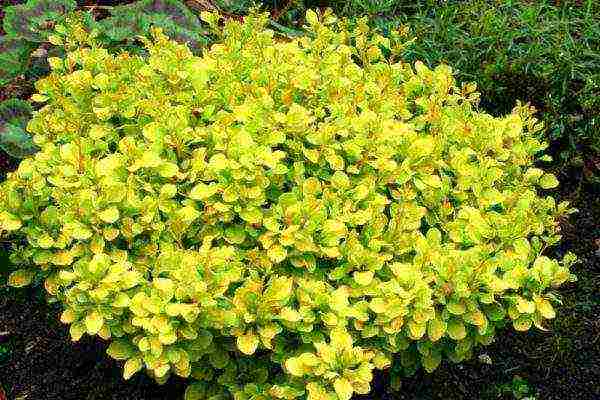
Barberry Thunberg Special Gold stands out for its bright golden foliage
Video: variegated forms of barberry Thunberg
Fast growing barberries
The fastest growing varieties of barberry also belong to the Thunberg species. They have a number of distinctive features:
- An adult plant can grow up to three meters in height.
- The branches and trunk of shrubs are covered with thorns up to 1 cm long.
- The leaves are small, oblong, 1–3 cm long. The foliage is colored red in autumn and falls off in the winter.
- Flowering lasts from one to two weeks. Flowers have a yellow center, the outside is red.
- They bear fruit annually and are very abundant. The berries reach 10 mm in length and are elliptical in shape.
- Ripe fruits of bright coral color appear on the shrub in mid-autumn and hang on the branches for a long time.
Photo gallery: the fastest growing varieties of Thunberg barberry
Barberry varieties for the Moscow region
The main criterion for choosing varieties and types of barberry for the Moscow region is their resistance to frost and urban conditions. The most popular species in this region are:
- barberry Ottawa;
- common barberry;
- barberry Thunberg.
Let's take a closer look at individual representatives of each of the species.
Barberry Alba variegata
Alba variegata — a kind of common barberry. The leaves of this shrub are distinguished by unusual white spots. Barberry Alba variegata reaches up to 1.5 m in height. It is unpretentious, frost-resistant, tolerates heat well, does not like stagnant moisture. It is preferable to place the shrub in a sunny location.
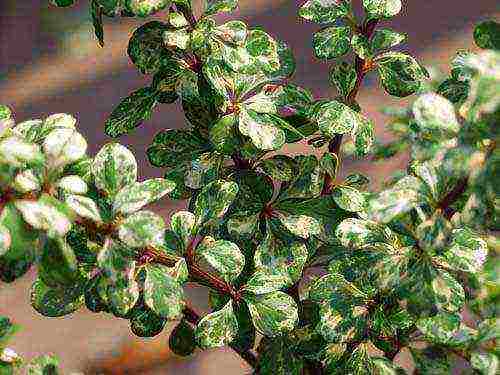
Barberry Alba variegata is distinguished by beautiful green leaves with white spots
Barberry Ottawa Superba
Barberry Superba can reach a height of up to 3 meters. The leaves of this shrub have a purple hue. The flowers are yellow with a red border around the edges, blooming in May. In June, bright red berries appear on the bushes, which can be eaten. The variety is frost-resistant, undemanding to soil and environment.
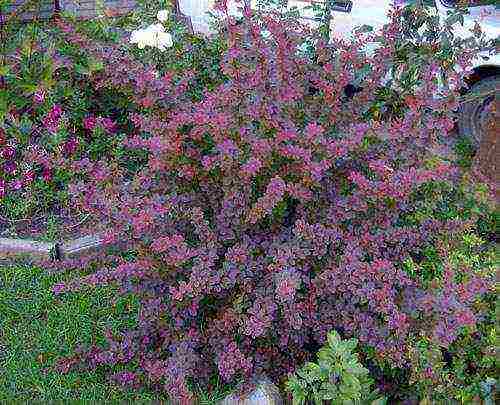
Ottawa barberry Superba with purple leaves retains its bright color even in the shade
Barberry Thunberg Atropurpurea
This variety of barberry is rather low (up to 1m), with a flat-round crown shape. The leaves are dark purple in color, sometimes with a purple tint. The shrub blooms in May. Its flowers are small, painted yellow. Closer to autumn, bright red oblong berries appear on the bushes.
Atropurupurea prefers sunny and bright locations, but can tolerate shade. Resistant to heat and cold, does not like moisture stagnation.
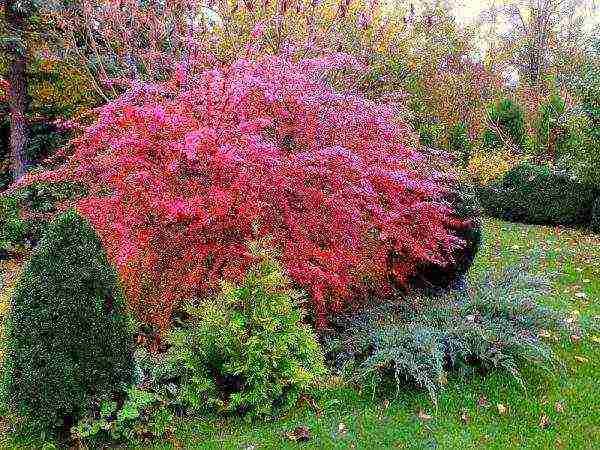
Barberry Atropurpurea can be used as a bright accent color in garden compositions
Types of barberry for Siberia
Siberia has a rather cold climate and a long frosty period. In such conditions, only some types of barberry are able to grow well, such as:
- Siberian barberry. A shrub that grows no more than 1 m in height. Its branches are covered with thorny thorns, the leaves also have thorny teeth at the edges. Blossoming of Siberian barberry begins in May, by the end of summer, red oblong fruits appear on the branches. Resistant to low temperatures, unpretentious.
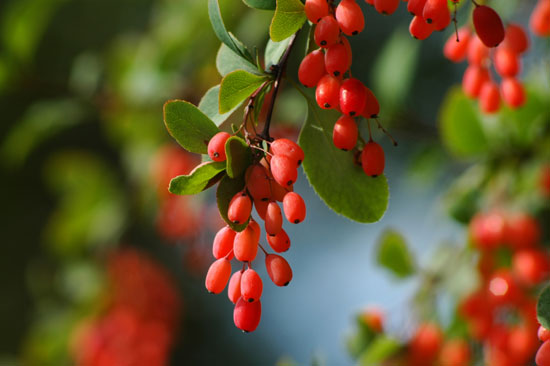
Siberian barberry is unpretentious and resistant to the harsh climate of Siberia
- Amur barberry. We already got to know this species a little at the beginning of the article. In the wild, the shrub is found along the banks of mountain rivers and on the forest edges of the Far East. It has been used in landscaping since the end of the 19th century. Good for hedges. Beautiful Amur barberry bushes lend themselves well to cutting, and thin sharp thorns can protect your estate from uninvited guests.
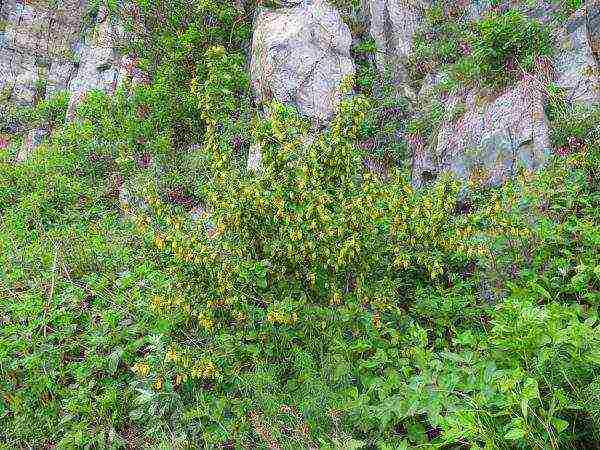
Wild bushes of Amur barberry can be found on the rocky coast of Primorsky Krai
- Common barberry. For cultivation in Siberia, the red-leaved form of barberry, Atropurpurea, is most often recommended. This variety is most adapted to harsh winters.
Video: useful properties and use of Siberian barberry
Reviews
Barberry has many types and varieties, each of which is unique in its own way. Due to its unpretentiousness, it is very popular among gardeners. Certain types of barberry are able to withstand temperatures down to -40 degrees. The shrub is widely used in landscaping areas, parks and residential areas.
Rate the article:
(1 vote, average: 5 out of 5)
Barberry belongs to ornamental shrubs, it is not often found in the garden, but in vain, because this bush is absolutely not whimsical to care for. Its fruits are delicious and medicinal. Knowing which barberry seedlings are suitable for growing in your climatic zone, you can easily grow it in your area.
Varieties of edible barberry seedlings
There are up to 170 species of this bush, but only a few of them are common among gardeners. These are common barberry, Ottawa, Amur, Canadian and ball-bearing. There are forms with red, yellow, blue and white fruits.
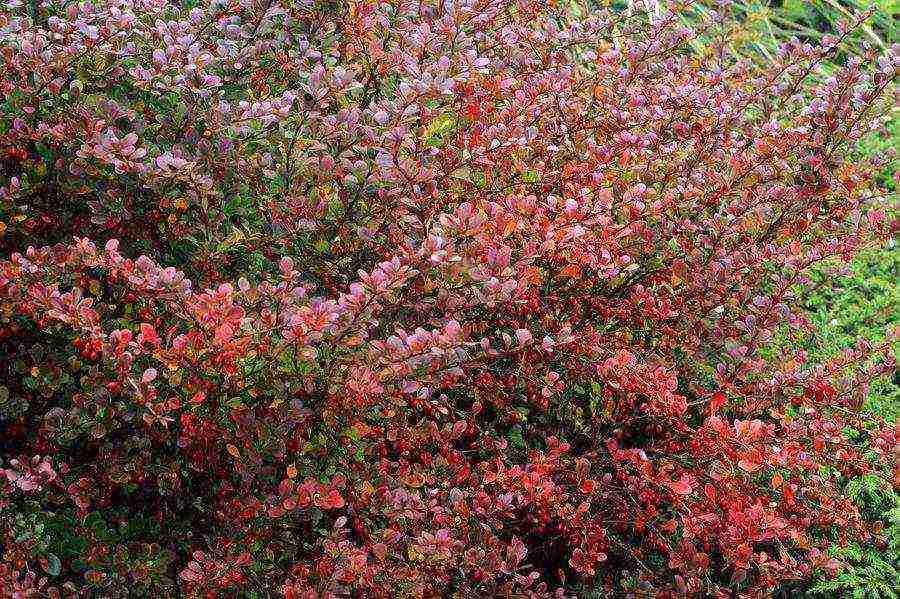
Barberry seedlings are planted in sunny areas
Bushes up to 3.5 m in height grow from seedlings of Amur barberry. The leaves are green, turn red by autumn. The fruits ripen in November. Popular variety "Japonica".
Ottawa barberry varieties:
- Auricoma;
- "Purpurea";
- Superba.
All these varieties have red berries.
Like the Ottawa barberry, the Canadian barberry is an edible hybrid. The bushes of the ball-bearing variety reach 2 m in height. The fruits are blue.
Varieties of common barberry seedlings
Among the edible species, it is the ordinary variety that is popular. The seedlings are frost-resistant, withstand frosts down to -35 ˚С. They easily tolerate drought, increased air pollution and are not demanding on the soil. Seedlings of this species do not tolerate waterlogged soil, therefore they are not planted near the occurrence of groundwater. The fruits of the common barberry are bright red oblong, up to 1 cm long. They ripen in early November.
Popular hybrid varieties of common barberry:
- "Lutea". Bushes grow up to 2 m in height. Fruits are yellow and sour. Seedlings are planted only in the sun.
- "Aureo-marginata". Tall bush up to 3 m in height. Gardeners are often used for decorative purposes as a hedge. Scarlet fruits are harvested in October.
- "Atropurpurea". The berries are harvested in early October. They are dark red in color.
- "Alba-variegata". Despite the fact that the variety belongs to edible varieties, it is more often grown for decorative purposes. The leaves are green with white streaks, the berries are creamy white.
- Dulcis. The species has excellent taste of berries. They are very sweet.
- Asperma. The berries are purple seedless.
In order for the seedlings to take root, it is advisable to purchase 3-year-old or 4-year-old bushes.
When planting any edible barberry variety, it is necessary to take into account that only in sunny areas you can get a bountiful harvest. Shrubs that grow in the shade are low-yielding, and their fruits are sour and not tasty.
See also: how to grow an oak from an acorn
